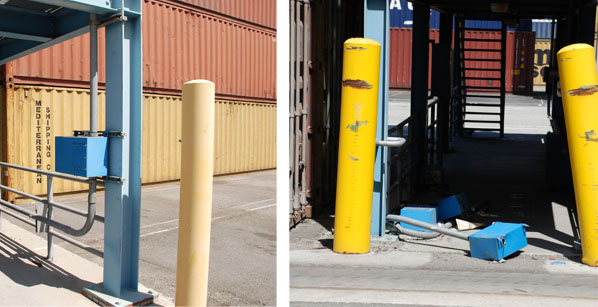Those who have plugged in Refrigerated Containers (a.k.a “reefers”) know firsthand that water intrusion can cause reefer plugs and connectors to explode. This is extremely dangerous and can result in injury to the operator, damage to the plug, receptacle, and surrounding equipment. And obviously, the refrigerated cargo is no longer being cooled. Experienced operators will even shake the plug prior to plugging in; if they suspect water is inside they know better than to energize the plug.
Read morePlugs and Connectors
Be Proactive: Help Prevent Container Drive-offs
PORT SAFETY
Many key factors play a role in getting cargo in & out of ports and on the road to their final destination. In the process of getting reefer containers from one destination to the next, it is important that precautionary measures are taken to mitigate the occurrence and impact of accidents and safety hazards.
WHAT IS A DRIVE-OFF?
Drive-offs in a port terminal happen when an operator moves refrigerated cargo containers while they are still connected to an electrical source such as a rack mount reefer outlet assembly (Fig. 1 & 2). When a drive-off occurs, the plug or receptacle are in danger of breaking away. This breakaway can result in damage to equipment and infrastructure. In addition, and more importantly, it could also create hazardous conditions.
MONETARY LOSS
Aside from being dangerous, damage to refrigerated cargo containers can also be costly. In addition to repair or replacement cost, disruption to operations due to the unavailability of the reefer container slot corresponding to the damaged reefer outlet should be considered. Drive-offs are especially disruptive in automated container terminals. For safety reasons the automated operation must be stopped in the all or part of the stacking row while repairs are performed. Units must be repaired quickly in order to allow operation to continue and reduce financial loss.
SOLUTIONS
In order to minimize drive-offs, ESL recommends plug sensing devices which can be added to Reefer Outlet assemblies. This solution contains a dry contact micro switch powered by a secondary source which can be used to help trigger a warning system (visual or integrated to TOS). This proactive option helps limit damage caused by human error which in turn, reduces operational costs and the need for replacement receptacles.
When it comes to breakaways, ESL offers receptacles made from polyamide, a non-metallic material designed to break easier under stress, preventing further damage to other components of the Reefer Outlet Assembly. This allows for easy replacement of broken receptacles and less operational time lost.
With increased education about the dangers of port drive-offs, and implementing precautions such as Safety-interlocked cord connected devices, injury and cost can be minimized. Learn more about ESL and how we can help keep your port safe by visiting our Intermodal page or contact us!
ESL’s Watertight Plug Install Video
ESL’s complete line of refrigerated container plugs and connectors are designed to withstand wet marine environments and ensure a watertight seal. Watch our recent video to learn how to correctly install ESL’s watertight plugs and connectors. Visit ESL’s Reefer Plugs, Connectors & Accessories page for further information on our product.
Want to see more videos like this? Watch ESL’s Magic Watertight Plug Video and see ESL’s playful take on a water ingress test.
London Gateway Project
London Gateway is a new ‘Super Port’ located North East of London with an ability to handle the world’s largest cargo ships. It increases the capabilities of the Port of Londonand helps meet the growing demand for container handling in The United Kingdom. Read more
Determining the Right Fit: Single-gang vs. Multi-gang Reefer Outlet (socket) Installations
When it comes to designing reefer racks, the question of whether to install individual reefer outlets (sockets) or group several outlets in a single enclosure (multi-gangs) is often overlooked. Past experiences or canned designs seem to be the driving factors behind selecting one of these alternatives. This is a decision that impacts both installation costs & operations, and requires some consideration. Read more



